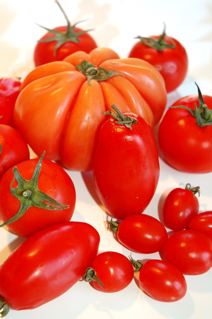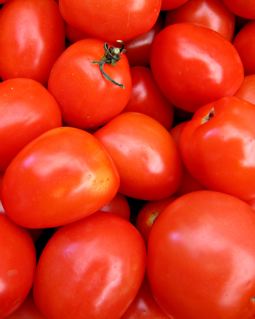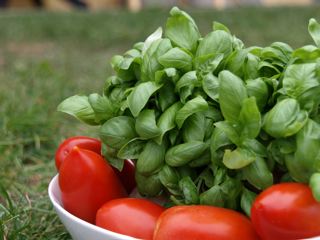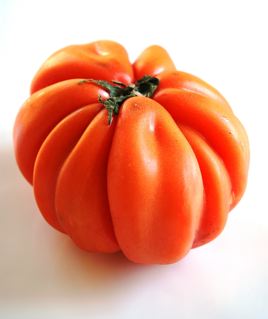 Tomatoes qualify as a very popular non-starchy “vegetable” (even if they are botanically a “fruit” per se) based on per capita consumption in the USA, second only to potatoes.
Tomatoes qualify as a very popular non-starchy “vegetable” (even if they are botanically a “fruit” per se) based on per capita consumption in the USA, second only to potatoes.
Year 2005 data from USDA noted tomato consumption from various sources, including primarily canned & frozen, as well as some fresh, to be close to 100# of farm weight/per person/per year.
The next closest non-starchy vegetable category item, carrots, was noted to have consumption levels at just above 10# of farm weight/per person/per yr.
(Different Tomatoes 2 graphic courtesy of salsachica at rgbstock.com)
What contributes to the wild popularity of tomato products?
- For one thing, due to canning and freezing options, tomatoes are available year round no matter where you might live. Properly canned/jarred products are shelf-stable, meaning families don’t have to deal with potential spoilage issues.
- Preparation time is actually quite minimal for tomatoes. Easy 10MinuteFlavor! Open a can of tomato paste, tomato puree, stewed tomatoes, diced tomatoes, etc., with a safety lid style can opener; defrost frozen content in a pan on the stove or in a microwave safe non-staining container; or easily wash fresh product as needed and then cut-up using a scalloped/serrated edge knife.
- There is minimal waste as only if you are seeding fresh tomatoes is there any real product weight loss to consider as it is much rarer to remove tomato skin from fresh tomatoes–most often that is done for canned tomatoes.
 With increased consumer awareness of cancer prevention today, more people are turning to tomatoes, and actually to canned tomato paste, richest in the anti-oxidant lycopene (~7x more per volume measure than raw tomatoes), to use when making homemade tomato sauce dishes to boost the benefits of consuming tomatoes.
With increased consumer awareness of cancer prevention today, more people are turning to tomatoes, and actually to canned tomato paste, richest in the anti-oxidant lycopene (~7x more per volume measure than raw tomatoes), to use when making homemade tomato sauce dishes to boost the benefits of consuming tomatoes.
You might recall from our series this spring addressing prostate cancer that lycopene availability is increased with heat processing and with the addition of a small amount of a healthy fat such as extra virgin olive oil (EVOO), since lycopene is fat soluble.
(Image of ripe roma tomatoes courtesy of TACLUDA via rgbstock.com)
No added salt versions of canned tomato products make it easier to watch one’s sodium intake as well.

Consuming tomato products is a great way to fight oxidative stress!
When it comes to tomatoes, consumers are interested in emerging research involving tomato consumption and positive associations addressing body weight control, bone health, brain health, and skin health.
Because of their high water content, tomatoes are both refreshing and lower in calories.
(Image of tomatoes in bowl with basil called Vegetable’s courtesy of gabriel77 via rgbstock.com)
ConAgra Foods offered a webinar from their NutriBites ℠ Webinar Series focusing on tomatoes in March 2011 ( Tomatoes: The Best Liked but Least Recognized Super Food featuring Britt Burton-Freeman, PhD, MS –Director, Center for Nutrition Research, Institute for Food Safety and Health, Illinois Institute of Technology and Kristin Reimers, PhD, RD –Manager, Nutrition, ConAgra Foods) and specifically mentioned the following positive aspects of a Tomato Nutrient Profile as a source of:
- “Vitamins C & E;
- Mineral potassium,
- Some fiber;
- Carotenoids (lycopene, beta carotene aka Vit A, lutein & zeaxanthin, and the phytoene, phytofluene);
- Flavonoids (quercetin aka rutin, naringenin, kaempferol);
- Phenolic acid chlorogenic acid; and
- Glycoalkaloids (alpha tomatine, and dehydrotomatine)”
Since the 2010 Dietary Guidelines for Americans urge consumers to take in 5.5 cups per week of red/orange produce, tomato consumption is right in line with that advice.
Year round it is easy to drink tomato juice or other vegetable juice mixtures that includes tomatoes in them.
In winter time it is easy to have more homemade pizza, casseroles with tomatoes, ratatouille, Indian tomato-based curried dishes, tomatoes added to crockpot bean stews, tomato rich soups, or canned/jarred products.
In cold weather months, it is easy to build homemade “pasta sauce” starting with tomato paste (after all, if you’ve ever read the label on a jar of spaghetti sauce, you’ve realized that tomato puree is merely tomato paste plus water).
 Every cook has their favorite type of tomatoes for making tomato sauce, but most agree that the San Marzano DOP plum tomato variety, known to grow in the outskirts of Naples, Italy, is an exceptional one to base a sauce upon. Our ancestor, Matilda, from Procida, Naples, Italy, loved those plum tomatoes before they were well known in America (and before the DOP designation was added to the name San Marzano).
Every cook has their favorite type of tomatoes for making tomato sauce, but most agree that the San Marzano DOP plum tomato variety, known to grow in the outskirts of Naples, Italy, is an exceptional one to base a sauce upon. Our ancestor, Matilda, from Procida, Naples, Italy, loved those plum tomatoes before they were well known in America (and before the DOP designation was added to the name San Marzano).
The Ciro-3 variety of San Marzano DOP is now grown by about 98% of the growers who farm in the Naples, Italy region with the intent of canning the tomatoes grown for export. The DOP zone is a small area considered to be southeast of Mount Vesuvius where previous volcanic eruptions means the soil is quite fertile.
Other varieties of the San Marzano DOP include the Smeck-20 which is an older variety, and a less desirable F-40 that works well with farm machinery, but the tomato itself tends to be very firm–almost hard–and thus is a less desirable cultivar.
Summer time provides access to vine ripened, delicious fresh tomatoes to build meals around. Just 1/2 cup/day of fresh tomatoes in the summertime can provide welcome nutrients, while keeping calorie levels down as we previously noted.
 Summertime is also a popular time for salsas (served solo or used in reduced fat tacos and reduced fat enchiladas), salsas made with additional vegetables, salsas made with additional fruits, an occasional cooling gazpacho that can be rich in tomato content, or even refreshing desserts.
Summertime is also a popular time for salsas (served solo or used in reduced fat tacos and reduced fat enchiladas), salsas made with additional vegetables, salsas made with additional fruits, an occasional cooling gazpacho that can be rich in tomato content, or even refreshing desserts.
Try combining some seeded, finely cubed watermelon pieces with diced tomatoes, and even a little pink grapefruit perhaps (those are three top sources of lycopene) and some healthier seasoning options.
When summer is ending and evenings cool down again, baked tomatoes can be a lovely side dish to prepare and serve warm or folks can grill tomatoes outdoors instead. (Image of Cuore variety of tomatoes from Italy courtesy of salsachica via rgbstock.com)
We’ve previously mentioned some sources of recipes to explore and the American Institute for Cancer Research even offers Health-e-Recipes that arrive via e-mail. Just this week a recipe arrived for Chilled Roasted Tomato Soup, described as “plum tomatoes …blended with garlic, basil and rosemary for a low-calorie, flavorful combination.”
Heirloom tomatoes are making a comeback in some marketplaces as more organic growers express an interest in those classic varieties. Newer varieties of non-heirloom tomatoes often pale in comparison to the wonderful flavors some of the heirloom varieties have to offer as summer progresses.
Speaking of progress, on May 31, 2012 the tomato genome sequence (Solanum lycopersicum) was published in an issue of Nature, the result of countless years of work by the Tomato Genome Consortium spanning 14 countries (after all, the natural distribution of tomatoes is pretty much world-wide). The genome was sequenced from specifically the “Heinz 1706” tomato. Meanwhile, the genome sequence of the wild tomato (Solanum pimpinellifolium) was developed at Cold Spring Harbor Laboratory.
Lovers of tomatoes can be quite excited about this news since eventually better understanding the tomato genome sequence could lead to improved taste & ripening food quality for tomatoes that are grown in a wide variety of settings. For further details check out Solgenomics, Boyce Thompson Institute and Cornell University Press Office, as well as a page addressing the tomato genome sequence.

